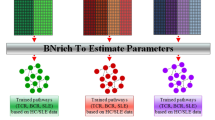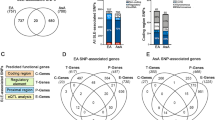Abstract
Systemic Lupus Erythematosus (SLE) is a complex autoimmune disease with limited therapeutic targets or clinical outcome predictors. This study aimed to gain more insights into the underlying immunological pathways and prognostic biomarkers of SLE. Integrated analyses of RNA-seq data from 64 SLE and 62 healthy controls, examining 27 immune cell types to explore the key pathways and driver genes in SLE pathogenesis. Single-cell RNA sequencing data from the skin and kidney were used to determine the association of COX5A expression with organ damage. The associations of COX5A with SLE phenotypes were further evaluated in two independent cohorts, and receiver operating characteristic (ROC) curves were constructed to assess the value of COX5A as a biomarker for disease activity and organ damage in SLE. We found that oxidative phosphorylation (OXPHOS) is the most significantly altered metabolic pathway in SLE, especially in effector T cells. Notably, we identified an OXPHOS-related enzyme, COX5A, whose expression was significantly higher in effector T cells than in naïve T cells and showed associations with disease activity, organ damage, and steroid treatment of SLE. Furthermore, ROC curves showed that COX5A is a robust biomarker for disease activity, kidney involvement, and new-onset skin lesions, with the area under the curve (AUC) values of 0.880, 0.801, and 0.805, respectively. Our results identified the OXPHOS signature as a prominent feature in SLE T cells, and COX5A as a potential candidate biomarker for disease activity and organ damage in SLE.






Similar content being viewed by others
Data availability
All data generated or analysed during this study are included in SI. 1.
Abbreviations
- AUC:
-
Area under the curve
- DEGs:
-
Differentially expressed genes
- GO:
-
Gene Ontology
- GSEA:
-
Gene Set Enrichment Analysis
- GSVA:
-
Gene Set Variation Analysis
- ISG:
-
Interferon-stimulated genes
- KEGG:
-
Kyoto Encyclopedia of Genes and Genomes
- LFSR:
-
Local false sign rate
- logCPM:
-
Log-transformed count per million
- MsigDb:
-
Molecular Signatures Database
- OXPHOS:
-
Oxidative phosphorylation
- PCA:
-
Principal components analysis
- PPI:
-
Protein–protein interaction
- qRT‒PCR:
-
Quantitative real-time PCR
- ROC:
-
Receiver operating characteristic
- SLE:
-
Systemic Lupus Erythematosus
- UMAP:
-
Uniform manifold approximation and projection
References
Carter EE, Barr SG, Clarke AE. The global burden of SLE: prevalence, health disparities and socioeconomic impact. Nat Rev Rheumatol. 2016;12(10):605–20.
Dunlap GS, Billi AC, Xing X, et al. Single-cell transcriptomics reveals distinct effector profiles of infiltrating T cells in lupus skin and kidney. JCI Insight. 2022. https://doi.org/10.1172/jci.insight.156341.
Arazi A, Rao DA, Berthier CC, et al. The immune cell landscape in kidneys of patients with lupus nephritis. Nat Immunol. 2019;20(7):902–14.
Mistry P, Nakabo S, O’Neil L, et al. Transcriptomic, epigenetic, and functional analyses implicate neutrophil diversity in the pathogenesis of systemic lupus erythematosus. Proc Natl Acad Sci U S A. 2019;116(50):25222–8.
Bashant KR, Aponte AM, Randazzo D, et al. Proteomic, biomechanical and functional analyses define neutrophil heterogeneity in systemic lupus erythematosus. Ann Rheum Dis. 2021;80(2):209–18.
Baechler EC, Batliwalla FM, Karypis G, et al. Interferon-inducible gene expression signature in peripheral blood cells of patients with severe lupus. Proc Natl Acad Sci U S A. 2003;100(5):2610–5.
Crow MK. Type I interferon in the pathogenesis of lupus. J Immunol. 2014;192(12):5459–68.
Soni C, Perez OA, Voss WN, et al. Plasmacytoid dendritic cells and type I interferon promote extrafollicular B cell responses to extracellular self-DNA. Immunity. 2020;52(6):1022-38 e7.
Landolt-Marticorena C, Bonventi G, Lubovich A, et al. Lack of association between the interferon-alpha signature and longitudinal changes in disease activity in systemic lupus erythematosus. Ann Rheum Dis. 2009;68(9):1440–6.
Panwar B, Schmiedel BJ, Liang S, et al. Multi-cell type gene coexpression network analysis reveals coordinated interferon response and cross-cell type correlations in systemic lupus erythematosus. Genome Res. 2021;31(4):659–76.
Morand EF, Furie R, Tanaka Y, et al. Trial of anifrolumab in active systemic lupus erythematosus. N Engl J Med. 2020;382(3):211–21.
Chapman NM, Chi H. Metabolic adaptation of lymphocytes in immunity and disease. Immunity. 2022;55(1):14–30.
Buck MD, Sowell RT, Kaech SM, Pearce EL. Metabolic Instruction of Immunity. Cell. 2017;169(4):570–86.
Ghosh-Choudhary S, Liu J, Finkel T. Metabolic regulation of cell fate and function. Trends Cell Biol. 2020;30(3):201–12.
Chi H. Regulation and function of mTOR signalling in T cell fate decisions. Nat Rev Immunol. 2012;12(5):325–38.
D’Souza AD, Parikh N, Kaech SM, Shadel GS. Convergence of multiple signaling pathways is required to coordinately up-regulate mtDNA and mitochondrial biogenesis during T cell activation. Mitochondrion. 2007;7(6):374–85.
Li F, Liu H, Zhang D, Ma Y, Zhu B. Metabolic plasticity and regulation of T cell exhaustion. Immunology. 2022;167(4):482–94.
Sugiura A, Andrejeva G, Voss K, et al. MTHFD2 is a metabolic checkpoint controlling effector and regulatory T cell fate and function. Immunity. 2022;55(1):65-81.e9.
Wagner A, Wang C, Fessler J, et al. Metabolic modeling of single Th17 cells reveals regulators of autoimmunity. Cell. 2021;184(16):4168-85.e21.
Morel L. Immunometabolism in systemic lupus erythematosus. Nat Rev Rheumatol. 2017;13(5):280–90.
Sharabi A, Tsokos GC. T cell metabolism: new insights in systemic lupus erythematosus pathogenesis and therapy. Nat Rev Rheumatol. 2020;16(2):100–12.
Takeshima Y, Iwasaki Y, Nakano M, et al. Immune cell multiomics analysis reveals contribution of oxidative phosphorylation to B-cell functions and organ damage of lupus. Ann Rheum Dis. 2022;81(6):845–53.
Shim JS, Kim EJ, Lee LE, et al. The oxidative phosphorylation inhibitor IM156 suppresses B-cell activation by regulating mitochondrial membrane potential and contributes to the mitigation of systemic lupus erythematosus. Kidney Int. 2023;103(2):343–56.
Johnson MO, Wolf MM, Madden MZ, et al. Distinct regulation of Th17 and Th1 cell differentiation by glutaminase-dependent metabolism. Cell. 2018;175(7):1780-95.e19.
Ota M, Nagafuchi Y, Hatano H, et al. Dynamic landscape of immune cell-specific gene regulation in immune-mediated diseases. Cell. 2021;184(11):3006-21 e17.
Zheng M, Hu Z, Mei X, et al. Single-cell sequencing shows cellular heterogeneity of cutaneous lesions in lupus erythematosus. Nat Commun. 2022;13(1):7489.
Butler A, Hoffman P, Smibert P, Papalexi E, Satija R. Integrating single-cell transcriptomic data across different conditions, technologies, and species. Nat Biotechnol. 2018;36(5):411–20.
Robinson MD, McCarthy DJ, Smyth GK. edgeR: a Bioconductor package for differential expression analysis of digital gene expression data. Bioinformatics. 2010;26(1):139–40.
Korsunsky I, Millard N, Fan J, et al. Fast, sensitive and accurate integration of single-cell data with Harmony. Nat Methods. 2019;16(12):1289–96.
Ritchie ME, Phipson B, Wu D, et al. limma powers differential expression analyses for RNA-sequencing and microarray studies. Nucleic Acids Res. 2015;43(7): e47.
Urbut SM, Wang G, Carbonetto P, Stephens M. Flexible statistical methods for estimating and testing effects in genomic studies with multiple conditions. Nat Genet. 2019;51(1):187–95.
Hänzelmann S, Castelo R, Guinney J. GSVA: gene set variation analysis for microarray and RNA-seq data. BMC Bioinform. 2013;14:7.
Yu G, Wang LG, Han Y, He QY. clusterProfiler: an R package for comparing biological themes among gene clusters. OMICS. 2012;16(5):284–7.
Shannon P, Markiel A, Ozier O, et al. Cytoscape: a software environment for integrated models of biomolecular interaction networks. Genome Res. 2003;13(11):2498–504.
Chin CH, Chen SH, Wu HH, Ho CW, Ko MT, Lin CY. cytoHubba: identifying hub objects and sub-networks from complex interactome. BMC Syst Biol. 2014. https://doi.org/10.1186/1752-0509-8-S4-S11.
Kirou KA, Lee C, George S, Louca K, Peterson MG, Crow MK. Activation of the interferon-alpha pathway identifies a subgroup of systemic lupus erythematosus patients with distinct serologic features and active disease. Arthritis Rheum. 2005;52(5):1491–503.
Luke A. J., O'Neill Rigel J., Kishton Jeff, Rathmell (2016) A guide to immunometabolism for immunologists Nature Reviews Immunology 16(9):553–565. https://doi.org/10.1038/nri.2016.70
(2017) Cytochrome c Oxidase Activity Is a Metabolic Checkpoint that Regulates Cell Fate Decisions During T Cell Activation and Differentiation Cell Metabolism 25(6):1254–1268.e7. https://doi.org/10.1016/j.cmet.2017.05.007
(2020) Calcium regulation of T cell metabolism Current Opinion in Physiology 17207–223. https://doi.org/10.1016/j.cophys.2020.07.016
(2022) Abnormalities of T cells in systemic lupus erythematosus: new insights in pathogenesis and therapeutic strategies Journal of Autoimmunity 132102870. https://doi.org/10.1016/j.jaut.2022.102870
(2022) (2022) (2021) An enhanced mitochondrial function through glutamine metabolism in plasmablast differentiation in systemic lupus erythematosus Abstract Rheumatology 61(7):3049–3059. https://doi.org/10.1093/rheumatology/keab824
Buang N, Tapeng L, Gray V, et al. Type I interferons affect the metabolic fitness of CD8(+) T cells from patients with systemic lupus erythematosus. Nat Commun. 2021;12(1):1980.
Tarasenko TN, Pacheco SE, Koenig MK, et al. Cytochrome c oxidase activity is a metabolic checkpoint that regulates cell fate decisions during T cell activation and differentiation. Cell Metab. 2017;25(6):1254-68.e7.
Acknowledgements
Not applicable.
Funding
This work was supported by the Joint Fund of Medical Sciences of the University of Science and Technology [grant number: YD9110002022].
Author information
Authors and Affiliations
Contributions
MC, YQ, JT, and ZC contributed to the conception of the work. MC and YQ analyzed the data. MC wrote the first draft and YQ, JT, and ZC made critical revisions to the manuscript. AW and HJn participated in the acquisition of data and laboratory studies and reviewed the manuscript. All authors read and approved the final manuscript.
Corresponding authors
Ethics declarations
Competing Interest
The authors have no relevant financial or non-financial interests to disclose.
Consent to participate
Written informed consent was obtained from all individual participants included in the study.
Ethics approval
This study was performed in line with the principles of the Declaration of Helsinki. Approval was granted by the institutional ethics committee of the First Affiliated Hospital of University of Science and Technology of China.
Additional information
Publisher's Note
Springer Nature remains neutral with regard to jurisdictional claims in published maps and institutional affiliations.
Supplementary Information
Below is the link to the electronic supplementary material.
Rights and permissions
Springer Nature or its licensor (e.g. a society or other partner) holds exclusive rights to this article under a publishing agreement with the author(s) or other rightsholder(s); author self-archiving of the accepted manuscript version of this article is solely governed by the terms of such publishing agreement and applicable law.
About this article
Cite this article
Cai, M., Qin, Y., Wan, A. et al. COX5A as a potential biomarker for disease activity and organ damage in lupus. Clin Exp Med 23, 4745–4756 (2023). https://doi.org/10.1007/s10238-023-01215-w
Received:
Accepted:
Published:
Issue Date:
DOI: https://doi.org/10.1007/s10238-023-01215-w




